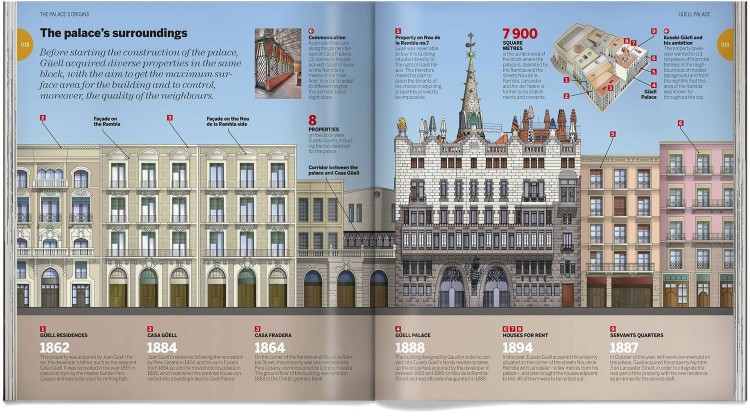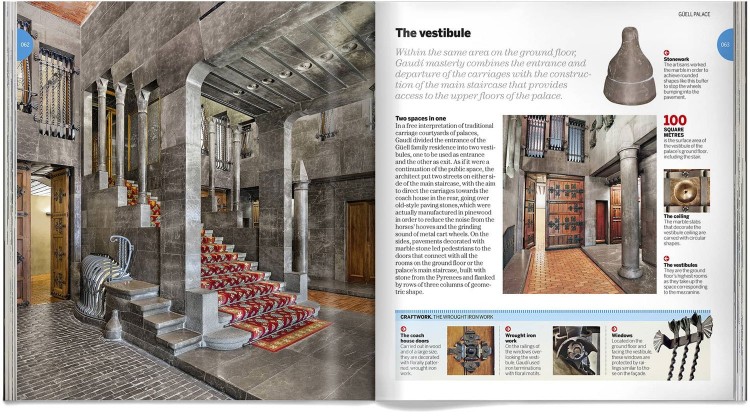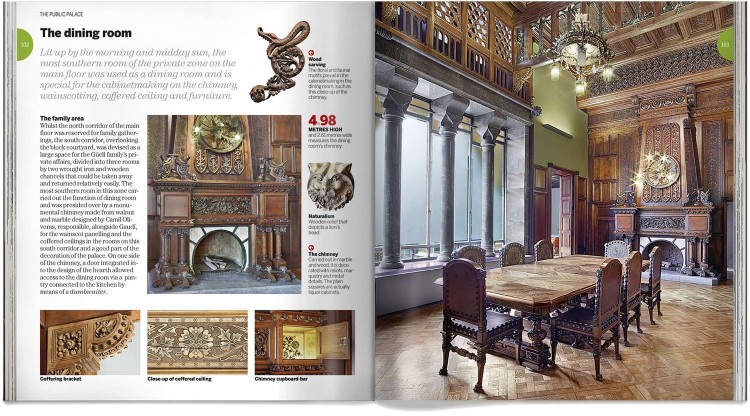Güell Palace
An avant-garde residence for modern-day life
RETURN
About the book Palau Güell
Declared a World Heritage site in 1984, Güell Palace or Palau Güell is one of the great masterpieces designed by Antoni Gaudí in Barcelona. This avant-garde residence devised for aristocratic use brings together luxury and functionalism, with its restrained appearance that contrasts with its location, in one of the most run-down neighbourhoods of late 19th century Barcelona.
Palau Güell was Gaudí's first major collaboration with Eusebi Güell, a man of great prestige amongst the upper-class and the working class, who ended up converting into the architect's main sponsor. Taking full advantage of the total free rein he was given, Gaudí carried out a daring and imaginative proposal, framed in modernist architecture, which allowed him to make the most of the space he had at his disposal.
This book on Palau Güell, published by Dosde contains detailed analysis about this unique work, in which Gaudí knew how to combine the most innovative resources with the rational use of architectonic and decorative elements of modernist art. The book covers the origins and the historical context of the project, while at the same time delving into each one of the nooks and crannies that make up Palau Güell.
Palau Güell was Gaudí's first major collaboration with Eusebi Güell, a man of great prestige amongst the upper-class and the working class, who ended up converting into the architect's main sponsor. Taking full advantage of the total free rein he was given, Gaudí carried out a daring and imaginative proposal, framed in modernist architecture, which allowed him to make the most of the space he had at his disposal.
This book on Palau Güell, published by Dosde contains detailed analysis about this unique work, in which Gaudí knew how to combine the most innovative resources with the rational use of architectonic and decorative elements of modernist art. The book covers the origins and the historical context of the project, while at the same time delving into each one of the nooks and crannies that make up Palau Güell.
Visual Edition
Güell Palace
It includes exclusive digital content
Made with environmentally friendly paper
Official licensed product
Multilanguage: Available in 8 languages
About the book Palau Güell
Declared a World Heritage site in 1984, Güell Palace or Palau Güell is one of the great masterpieces designed by Antoni Gaudí in Barcelona. This avant-garde residence devised for aristocratic use brings together luxury and functionalism, with its restrained appearance that contrasts with its location, in one of the most run-down neighbourhoods of late 19th century Barcelona.
Palau Güell was Gaudí's first major collaboration with Eusebi Güell, a man of great prestige amongst the upper-class and the working class, who ended up converting into the architect's main sponsor. Taking full advantage of the total free rein he was given, Gaudí carried out a daring and imaginative proposal, framed in modernist architecture, which allowed him to make the most of the space he had at his disposal.
This book on Palau Güell, published by Dosde contains detailed analysis about this unique work, in which Gaudí knew how to combine the most innovative resources with the rational use of architectonic and decorative elements of modernist art. The book covers the origins and the historical context of the project, while at the same time delving into each one of the nooks and crannies that make up Palau Güell.
Palau Güell was Gaudí's first major collaboration with Eusebi Güell, a man of great prestige amongst the upper-class and the working class, who ended up converting into the architect's main sponsor. Taking full advantage of the total free rein he was given, Gaudí carried out a daring and imaginative proposal, framed in modernist architecture, which allowed him to make the most of the space he had at his disposal.
This book on Palau Güell, published by Dosde contains detailed analysis about this unique work, in which Gaudí knew how to combine the most innovative resources with the rational use of architectonic and decorative elements of modernist art. The book covers the origins and the historical context of the project, while at the same time delving into each one of the nooks and crannies that make up Palau Güell.
Readers opinions
(3)
RETURN
Reviews
(3)
An excellent book on Güell Palace with a high quality and detailed content.
Good photos and illustrations. A highly recommended book about Guell Palace.
One of the most complete books on Güell Palace, the content is very complete and the photos are very good.
Readers opinions
(3)
An excellent book on Güell Palace with a high quality and detailed content.
Good photos and illustrations. A highly recommended book about Guell Palace.
Additional Information
- Additional Information
- Subtitle: An avant-garde residence for modern-day life
- Weight (g): 477
- Binding: Paperback with flaps
- Size (cm): 17,5 x 19,5
- Author: Dosde
- Pages: 0
- Edition: Visual Edition
Güell Palace, the frist great project of Gaudí
By the mid-1880’s, Antoni Gaudí had already shown signs of his innovative spirit in early projects such as Casa Vicens, The Caprice in Comillas and the lodges in Finca Güell, and he had already taken on the task of Sagrada Familia Temple, which would result in being the most significant work of his entire career.
Nonetheless, it was the construction of Güell Palace which would spread his fame outside Barcelonan artistic circles and helped him become the most celebrated and popular architect of the city. Inaugurated in the year 1888, when the Universal Exhibition of Barcelona was in full swing, the palace was the first major commission by Eusebi Güell, an industrialist and politician that turned out to be Gaudí’s leading client as well as one of his closest friends.
Gaudí incorporated very imaginative solutions in the palace project whether it was in the development of rooms in relatively reduced spaces or in the decorative details that were characteristic of an aristocratic abode. This was how an innovative and avant-garde palace emerged in shabby and ancient surroundings during late nineteenth century Barcelona, a work that in 1985 was declared to be of World Heritage interest by UNESCO.
Nonetheless, it was the construction of Güell Palace which would spread his fame outside Barcelonan artistic circles and helped him become the most celebrated and popular architect of the city. Inaugurated in the year 1888, when the Universal Exhibition of Barcelona was in full swing, the palace was the first major commission by Eusebi Güell, an industrialist and politician that turned out to be Gaudí’s leading client as well as one of his closest friends.
A visit to the Güell Palace of Barcelona
In the late nineteenth century, most middle class families were eager to build their new stately homes in the new part of Barcelona. Nonetheless, Güell chose to construct his residence in the Old Quarter. Thus, Gaudí's palace was built on a site on a street called Nou de la Rambla, in a district that after having been the industrial centre of the city in the 18th century, had become very run down due to the proliferation of factories and the oppressive, surrounding medieval walls.Gaudí incorporated very imaginative solutions in the palace project whether it was in the development of rooms in relatively reduced spaces or in the decorative details that were characteristic of an aristocratic abode. This was how an innovative and avant-garde palace emerged in shabby and ancient surroundings during late nineteenth century Barcelona, a work that in 1985 was declared to be of World Heritage interest by UNESCO.






























